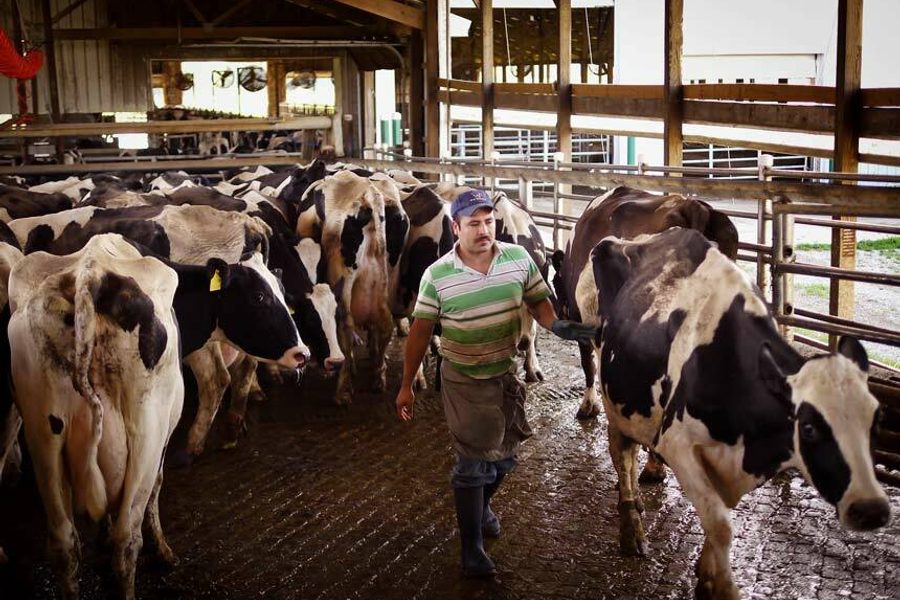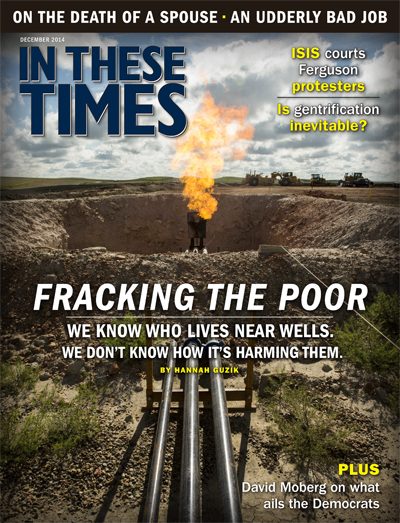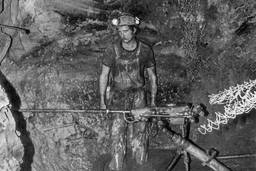The One Thing Worse Than Big Dairy’s Abuse of Cows? Its Abuse of Workers.
While the dairy industry’s cruel treatment of cows has been well documented, workers face vile and often dangerous conditions.
Joseph Sorrentino

New Mexico’s dairies, like almost all dairies in the United States, never stop running. Cows are milked two or three times a day, every day. “Cows don’t know holidays,” says Alfredo Gomez, a 56-year-old dairy worker in southeastern New Mexico. “Here, there’s no Christmas.” For the vast majority of dairy workers in New Mexico, as in most states, there’s also no holiday pay, no overtime, no sick pay and no workers’ comp. They work in dirty, difficult and sometimes dangerous conditions for an industry they’re convinced values milk over milkers.
Dairy is big in New Mexico. Big in number of cows, with approximately 320,000 statewide; big in average herd size, with about 2,200 cows per dairy (the largest in the nation); and big in economic impact. Dairy is the number one agricultural commodity in the state. The value of New Mexico’s milk production topped $1.5 billion last year. When you factor in milk processing, goods and services purchased by the industry, and the wages workers spend locally, dairy’s total economic impact on the state is over $4 billion annually. The industry also provides more than 3,000 dairy jobs and 14,000 other jobs statewide.
Big Dairy goes to great lengths to project a small image. It portrays itself as comprised of family farms, and as an industry deeply concerned about its cows and its workers. Photographs on dairy co-op and lobbying websites show clean black-and-white Holsteins sprawled in lush green fields, with calves being bottle-fed by smiling young Anglos.
At best, that’s a gross misrepresentation. Three-quarters of workers are Mexican, and most of the milk produced in New Mexico (and nationwide) comes from concentrated animal feeding operations, or CAFOs. Cows don’t graze in green pastures. Instead, they are kept in corrals, standing on dirt or, more frequently, in the muck that is generated by their urine and feces. A dairy cow expels as much as 150 pounds of manure a day.
“Basically, all the cows are walking in the waste; nothing’s clean,” says Roberto Achoa, a soft-spoken college student who began working in dairies as a sophomore in high school. Like Gomez and all but two of the workers interviewed for this piece, Achoa requested a pseudonym for fear of retaliation from dairies.
Achoa is what’s known as a corralero, the person who drives the cows from their pens to the milking barns. Corraleros get plenty of exercise. “You walk and walk to get the cows and never stop,” says José Varela, who worked on dairies for several years. “Maybe you’re fat when you start, but in three months, you’re a skeleton.” It’s a dirty and treacherous job. Achoa says, “People sink into the waste, get stuck.” Working in pens with 200 or 300 cows has other risks, explains José Martinez, another corralero. During storms, the cows get scared: “They can turn around and run at you. They’ll kick you, jump real high.”
At milking time, cows lumber from the corral toward the milking barns, the corralero behind them, shouting and often waving a small towel. The cows, who have done this thousands of times, know to file into the milking barn and line up in two rows along raised platforms. Milkers move quickly up and down the platforms, milking 2,000 or more cows in a shift.
“It’s nasty [work],” says Matías Soto, a short, strongly built 59-year-old originally from Durango, Mexico, who has worked in dairies in southeastern New Mexico for three years. “We have aprons, [but they get] completely covered in manure and urine.” The smell in a milking barn can be noxious. Just a few minutes in one can leave a lasting foul taste in your mouth. But, workers say, you get used to it.
A fly on a CAFO’s wall
On September 17, Mercy For Animals (MFA), a Los Angeles-based organization, released an undercover video showing cows being physically abused at Winchester Dairy, located in Dexter, a tiny town in southeastern New Mexico. The footage showed workers kicking and punching cows, and using tractors to hoist up and drag “downer cows,” cows unable to stand.
“Winchester Dairy’s owners allowed a culture of cruelty and neglect to flourish on this factory farm for far too long,” says Vandhana Bala, general counsel for MFA, adding that this was the organization’s sixth undercover operation, and all six, conducted at dairies around the country, found “horrific animal abuse.”
“This leads us to believe that cruelty and violence run rampant in the dairy industry,” Bala says. She adds that their investigations “resulted in criminal animal cruelty convictions of workers, managers and even owners.” According to published reports, after the video’s release, Winchester Dairy closed the farm and fired all of its workers, supplying police with the names of the 11 “most abusive.”
In the opinion of Tess Wilkes, a former attorney at the New Mexico Center on Law and Poverty (NMCLP) who has interviewed dozens of dairy workers, the Winchester Dairy workers were “unfairly blamed for an abuse that is actually just a glimpse of a much larger problem” in an industry where “profits are paramount.” Workers are under pressure to move the cows quickly and rarely receive any kind of training. Indeed, Bala says that MFA’s undercover investigator, who worked as a corralero, received no training during the time of the investigation.
This appears to be typical. “There’s no training — you just start working,” says Gustavo Varela, who, along with his brother José, were the only two workers willing to have their real names used. Gustavo worked at dairies for 10 years, feeding calves. Angelica Rosario, one of the very few female dairy workers, worked as a milker for a year and a half and agrees with Varela. “You just watch other people” to learn the job, she says.
The lack of training endangers not only cows, but also workers. Working with large animals poses a real risk of injury. In 2012, Wilkes was part of a team at the NMCLP that interviewed about 60 workers from various dairies in the state. Almost 80 percent of the workers said they had never received any safety training.
Most of the cows are docile, but not all. “The younger ones are dangerous,” says Antonio Jiménez, who worked in a dairy outside of Roswell during high school. “They don’t know how to be milked and [they] kick. Sometimes the ones that have just given birth [are dangerous], too.” The NMCLP survey found that 53 percent of the workers interviewed had been injured on the job, often more than once, and sometimes seriously.
In March, Matías Soto was working as a milker at a dairy in southeastern New Mexico. Somehow, a bull had gotten mixed in with the cows and stuck in one of the milking parlor gates. As Soto was trying to free the bull, he says, “It lowered its head and attacked me, lifting me 6 or 7 feet in the air. I hit my head on the concrete floor.” His skull fractured. But, he says, he wasn’t taken to the ER in Artesia, about 40 miles away, for three hours. He then had to be airlifted to a hospital capable of handling his injury. The cost of the helicopter alone was more than $60,000, and Soto’s hospital bills were in “the tens of thousands of dollars,” says María Martínez Sánchez, a former attorney at the NMCLP who worked with Soto. And the dairy had no workers’ compensation insurance.
Its medical insurance covered Soto’s medical bills, but not all of the helicopter costs. Instead, says Martínez Sánchez, Soto went into debt, borrowing from friends and relatives, although he eventually received a small amount of money in a settlement with the dairy.
Injuries: part of the job
Workers’ comp is designed to cover a portion of workers’ medical expenses and lost wages if they’re hurt on the job. In Soto’s case, it would have covered all of his accident-related bills, plus some of the wages he lost during the time he had to take off work.
Requirements vary from state to state, and New Mexico has long exempted dairies and farms from having to insure field workers and people working directly with animals. In 2011, in a lawsuit brought by three dairy workers (on which Martínez Sánchez was an attorney), a District Court judge declared the exemption unconstitutional. But New Mexico’s Workers’ Compensation Administration (WCA) appealed, arguing that the ruling only applied to the three workers named in the suit. The WCA website now says that farm and ranch employers are“strongly encouraged” to get worker’s comp and that several pending cases will clarify the law.
Although Soto’s injury occurred after the 2011 ruling, many dairies were still not carrying the insurance because of the WCA’s initial statement. Without workers’ comp, “either the worker doesn’t get medical care, they go into great debt, or they are so injured they have to go to the emergency room, and the taxpayer pays,” says Martínez Sánchez. “As taxpayers, we’re subsidizing the agricultural industry.”
Not all injuries are as catastrophic as Soto’s, but injuries are part of the job. Unless debilitated, however, dairy workers are loathe to take time off. Pedro Garcia says he didn’t go on sick leave earlier this year when a cow stepped on his foot, fracturing it. “The boss said I have to work,” he says. “If you miss a day, you get fired.” That’s exactly what Juan Álvarez, a 37-year-old from Chihuahua, Mexico, says happened to him: A cow kicked him, breaking his leg, and he was out of work for three months. Although the dairy paid for his hospital stay, he lost his job.
Francisco Paredes is a majordomo (supervisor) at a large dairy outside of Clovis and, surprisingly, he was willing to talk about dairy work, which he’s done for close to 30 years. Even he is not salaried, and is reluctant to take any time off. “If I do not work a day, I do not earn any money,” he says. “The patron makes the rules. We know nothing of the law, nothing of the government. If I or another worker has something to do … or I am sick, I have to find the replacement and pay them.” Although workers at some dairies said their employer handles this, many said it was their responsibility — simply the way things are done.
In years of working with agricultural workers, Martínez Sánchez says she hasn’t heard anything like this. “It’s outrageous,” she says, her voice rising with anger. “It’s absolutely illegal. You can’t make somebody pay somebody else. To owners of dairies, these workers are expendable, almost not human. One gets sick or injured, and they’re out the door. There are countless more to take that position. It’s very callous, demoralizing and dehumanizing.”
No laws, no problem
Roberto Achoa started working as a corralero in a dairy in south central New Mexico when he was 16. The Department of Labor (DOL) places no restrictions on 16-year olds working in agriculture. Like many high school students in that area, Achoa worked after school from 4 p.m. to 11 p.m., plus from 7 a.m. to 3 p.m. on Saturdays. “The hours they gave you [meant] you got out of school, went straight to work, got out at 11, go to sleep and then school starts,” he says. The only time he’d get a day off is when he’d show up only to be sent home because the dairy had too many workers.
The work is nonstop. Although some workers say they get a lunch break— ranging from 30 minutes to just 5 — the majority say they get no breaks. “You’re eating your burrito,” says Martinez, the corralero, “and a damn cow’s shitting right next to you.” Or worse. Soto, who worked as a milker, says, “Sometimes you’re eating and taking a bite of a burrito, and a cow will shit on the burrito, and you have to throw it away.” Diego Jacinto has worked in dairies for over 10 years and has a special technique for keeping flies and manure off his meals. He demonstrates, miming that he is holding a burrito. He pretends to take a bite and then quickly stuff it under his shirt as he hurries along.
Dairy owners may not be violating any laws by denying workers breaks. According to the DOL, the Fair Labor Standards Act “does not require breaks or meal periods be given to workers.” Any breaks are considered a “benefit [and] a matter of agreement between the employer and the employee.” Nor does New Mexico law require breaks.
People continue to do dairy work because it’s steady, year-round employment and, at least on the surface, it pays well compared to other farm work, which is often the only alternative in the area. But it’s challenging to get accurate data on how much the average dairy worker actually earns, and few sources are in agreement. Surveys have found average annual salaries anywhere from $22,000 (in Atlanta) to $29,000 (in Denver). Compared with other agricultural work, that seems like decent pay. But a closer look reveals it’s not.
Alfredo Gomez is a youthful 56, with short-cropped gray hair and a neatly trimmed mustache. He’s a friendly man, but he doesn’t like smiling for photographs because he’s missing most of his front teeth. His job is feeding the cows, which he says isn’t too strenuous, although he wakes up at 2:30 a.m. and works 12-hour days.
Like most dairy workers, Gomez is paid a daily rate and doesn’t know his hourly wage — and it’s nearly impossible to figure out. His biweekly pay stubs contain no record of days or hours worked. He made just over $34,000 in 2013, a decent salary, but he worked 12 hours a day, six days a week, and sometimes more. Based on his typical schedule, that means his hourly rate was somewhere between $7.84 and $9.20. He never received overtime pay.
Most workers interviewed for this article said they had to work an hour or two past their shift several times a week without compensation. The NMCLP survey found the same.
By federal and New Mexico law, dairy workers — and all farmworkers — are exempt from getting paid overtime. And, according to Wilkes, they’re not entitled to any additional pay even when they work extra hours, as long as they are making more than the minimum wage and have no written contract entitling them to more pay, an arrangement that’s almost unheard of in agriculture.
In addition, many workers go unpaid during training (if they receive any). Workers interviewed for this article talked about unpaid training periods that lasted up to two weeks. That’s almost certainly illegal. According toJoy Forehand, the deputy cabinet secretary at New Mexico’s Department of Workforce Solutions, “In general, if an employer requires employees to attend… work-related trainings, the employer must pay for that time.”
Despite everything, very few workers complain, afraid they will be fired and blackballed. Nearly half of the workers surveyed by Wilkes said they wanted to complain about working conditions, but virtually all decided not to because of fear of retaliation. Adding to the fear is the fact that, according to Wilkes’ estimates, more than half of the workers are undocumented. “Dairies prefer these people,” says Jacinto, “because they are afraid to complain.” If workers don’t speak out and file lawsuits, working conditions are unlikely to change.
But there’s an interesting class-action lawsuit being brought by two consumers against DariGold, one of the largest dairy processors in the country, that may bring some relief to workers in the Northwest and set an example. Milk is provided to the Seattle-based DariGold by the 550 member dairies of the Northwest Dairy Association. DariGold’s 2010 Corporate Social Responsibility Report states that its suppliers provide excellent care for their animals, are concerned for workers’ safety and provide a “culture of respect and engagement.” According to the lawsuit, that’s far from true: Cows are mistreated and workers are denied basic labor rights such as lunch breaks, drinkable water and an environment free of discrimination. If successful, the lawsuit could change not only DariGold’s marketing but also how workers and cows are treated, and serve as a model for litigation in other states.
Workers in New Mexico’s dairy regions don’t have many options for work. In the southeast, it’s the dairies or the oil fields, which pay better but are more dangerous and farther from workers’ homes. In the south central region, it’s dairies or farm work, which pays even less. So workers stay quiet and trudge in day after day, knowing how little they’re valued. Every worker interviewed for this article was asked if they believed dairy owners valued cows or workers more. Without hesitation, each answered, “Cows.”
Angelica Rosario adds, “They treat the cows like a person and the workers like slaves.”
This reporting was supported by the Fund for Investigative Journalism.








